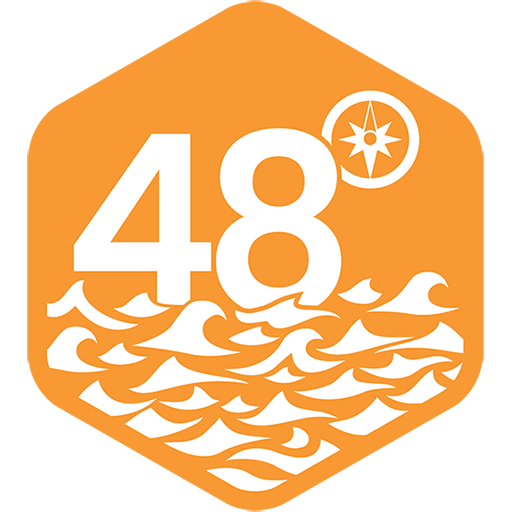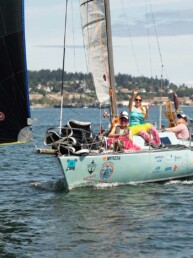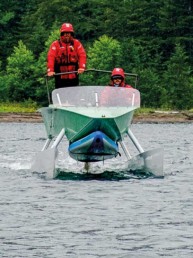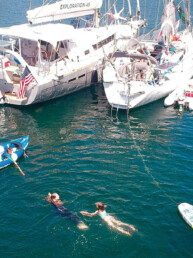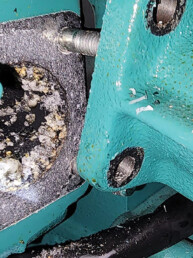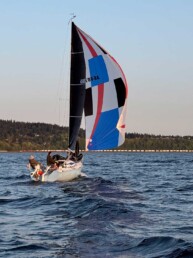Slowing Down in Desolation Sound

Recently I met a boater who cruised a 32-foot Sea Ray from Seattle to Cortes Island, British Columbia, and back in one day.
“Did you stop for dinner in Roche Harbor?” I joked. “How about cocktails in Nanaimo? Did you harvest any oysters?”
Speed was the point of his 400-plus mile trip, and as a boater who once spent an entire day going through customs in B.C. with my vessel, I was amazed at his navigational and logistical skills. My experience boating at Cortes Island last summer was very different, requiring a lengthy border crossing by car at the Peace Arch, three ferries (Tsawwassen, Campbell River, and Heriot Bay), and a road trip up the coast of Vancouver Island.
Located at the entrance of Desolation Sound in the northern reaches of the Salish Sea, Cortes Island is a destination requiring patience and persistence, especially when leaving from Seattle or Vancouver. It took me two full days to drive there. And the three small inflatable boats my husband, Frank, and I brought ensured that we were going nowhere fast, at least on the water. Over the years we have ventured to Desolation Sound in a 26-foot sailboat, a 42-foot trawler, and various commercial vessels. Yet, last summer when we stayed in a cabin in the woods with our inflatables, I felt like I was seeing it for the first time.
In Praise of Slowness
 “Dammit! Please Slow Down,” read the sign at the entrance to Cortes Bay, located on the southeastern side of the island. Referring to boat wakes, the message nonetheless seemed like words to live by. As we puttered, rowed, and paddled along the shoreline, Frank and I quickly fell under the island’s spell, appreciating the relaxed pace and noticeable quiet that our small boats provided. I thought about Carl Honoré’s book, In Praise of Slowness: How a Worldwide Movement is Challenging the Cult of Speed (2004), which recommends quality over quantity and the joy of living in the moment. The slow movement is a global initiative stemming from the slow food movement, which calls for mindful preparation with simple, locally sourced ingredients.
“Dammit! Please Slow Down,” read the sign at the entrance to Cortes Bay, located on the southeastern side of the island. Referring to boat wakes, the message nonetheless seemed like words to live by. As we puttered, rowed, and paddled along the shoreline, Frank and I quickly fell under the island’s spell, appreciating the relaxed pace and noticeable quiet that our small boats provided. I thought about Carl Honoré’s book, In Praise of Slowness: How a Worldwide Movement is Challenging the Cult of Speed (2004), which recommends quality over quantity and the joy of living in the moment. The slow movement is a global initiative stemming from the slow food movement, which calls for mindful preparation with simple, locally sourced ingredients.
“Why not slow boating?” I asked Frank.
Speed has its place when you’re trying to reach a destination during limited vacation time or trying to outrun a storm. It’s also great fun to fly across the water, especially in a race. It’s essential if you’re waterskiing. But there’s something to be said for an unhurried and thorough exploration of an area in a small vessel.
Before this trip, Frank and I had logged many hours in our dinghies, traveling to shore or visiting another anchored boat, occasionally stopping to admire a beach or point of interest. When the only boat available is a small inflatable, however, your perspective changes.
No one understood the value of small and slow better than Muriel Wylie “Capi” Blanchet, author of the beloved memoir The Curve of Time (published in 1961). During the 1920s and 1930s, she cruised Desolation Sound on a 25-foot boat with five children and a dog. The definition of “small” can be debated, but it seems Blanchet’s vessel Caprice qualified. The family meandered through coves and inlets for months, getting “lost somewhere down the centuries.” The “winding channels lured and beckoned,” she explained. “That was what we had been doing … just letting our little boat carry us where she pleased.”

Where the Wild Things Are
For our first tour of Cortes Island, Frank and I chose our roll-up inflatable equipped with a 1.7-horsepower EP Carry electric outboard. We launched from Cortes Bay on a calm, sunny morning, following the shoreline and turning south at the entrance. At one point we stopped along a cliff that dropped straight down into the clear water. Maneuvering up to the wall, we admired the bright purple hues of the ochre sea stars clinging to the side while multiple sea anemones waved their tentacles in the current and a sculpin scurried across the boat’s shadow. There was a whole world of activity going on below the surface, and we had front-row seats.


Our electric motor allowed us to approach wildlife in a quiet, unobtrusive manner that we call “stealth cruising.” The oystercatchers, for example, barely looked up as we passed by, continuing to poke at the rocks with their long orange-red bills. Frank noticed that these crow-sized black birds concentrated in an area that he later revisited at low tide. Wearing wading boots and clutching a bucket, he became something of an oystercatcher himself, harvesting his limit and bringing home dinner.
We continued exploring the shoreline of Cortes Island in a Takacat 8-foot inflatable catamaran. While it offered more space and stability, again we sat close to the water, allowing us to observe otters frolicking almost at eye level. Several seals surfaced next to the boat, peering at us with enormous liquid eyes that I had never noticed when viewing them from higher up on larger vessels.

At one point near Twin Islands, Frank and I saw three unmistakable black dorsal fins slice through the water. We had encountered orcas in Desolation Sound on several occasions, and it is typically a highly desirable, thrilling experience. Yet watching the fins rise to a height of about 6 feet, followed by a spyhop maneuver and giant splash, I felt an unexpected emotion: fear. Orcas look much larger from water level, especially when viewed from a tiny, slow vessel. I couldn’t help but think of recent stories of killer whale attacks along the Iberian Peninsula—bizarre tales of Revenge of the Cetaceans featuring deliberately destroyed rudders and sinking boats. Weirdly, the lyrics of a Jimmy Buffet song popped into my head: “Can’t you feel ‘em closing in, honey? Can’t you feel ‘em schooling around? You got fins to the left, fins to the right…” That tune is about human predators, I reassured myself, eyeing the orcas nervously.
“Let’s head back to Cortes Bay,” I suggested to Frank.

We took an inflatable two-person kayak to our next destination, Hague Lake, launching from the Kw’as Regional Park Trailhead. Bald eagles soared overhead as we paddled toward an island in the lake, surrounded by groves of cedar, spruce, and alder. A pair of great blue herons drifted over us squawking, looking like pterodactyls in a primeval setting, while mergansers kept pace on both sides of our boat. We became completely immersed in the wild on our return trip, when I accidentally tipped the kayak as we approached the shore. An ear infection had affected my balance, and the awkward climb out of my seat sent us both plunging into the warm, reedy water. As I lay floating, covered in various plants like a swamp creature, the deployment device activated in my life jacket, forming a thick collar around my shoulders and adding to my embarrassment. “Well, at least it worked,” I pointed out.
Just then I heard the call of a varied thrush, my favorite bird, which seemed to be watching from the forested shoreline. It’s an ethereal series of long, flutelike notes and was a perfect reminder of why we came here. Although Frank and I did not cruise a long distance by boat on Cortes Island, we got closer to nature than we ever had in bigger boats.

Inhabited Wilderness

Cortes Island is essentially a wild place. Wolves, bears, and cougars roam its forests, and one night Frank and I thought we heard the haunting yips of coyotes. For decades, promoters have praised this setting for being “untouched” and “unspoiled” (see, for example, Margaret Sharcott, “Tenting on Quadra and Cortes Island,” The Daily Colonist, Sept. 2, 1973). Even so, humans have been part of the environment here for thousands of years. Desolation Sound is located in the traditional territories of the Tla’amin and Homalco people, and Squirrel Cove on the eastern side of the island continues to serve as the primary village site of the Klahoose First Nation. The waters around Desolation Sound inspired Indigenous artwork that has endured through the centuries. Observant boaters can encounter petroglyphs (images carved in stone) and pictographs (images painted on stone with natural pigments) on shorelines and cliff walls. These ancient artifacts tell the stories of the people and creatures who tapped into the powerful natural forces of this watery place hundreds of years ago. A small boat allows a close view of the images, which should be approached with respect and left undisturbed.
With the arrival of Europeans, Cortes Island continued to be shaped by human presence and activity. Its name came from a 1792 Spanish expedition which sought to honor Hernán Cortés, a conquistador who led the colonization of Mexico during the 16th century. Also in 1792, British naval explorer Captain George Vancouver named (some would say misnamed) Desolation Sound, further conferring European sensibilities on Northwest waters. Over the centuries, Cortes Island attracted whalers, commercial fishers, miners, loggers, and farmers who all relied on the sea for materials or transport.
By the 20th century, recreational boaters had arrived, lured by tales of sheltered coves and anchorages surrounded by rugged peaks, steep forested slopes, picturesque waterfalls, and easily reached freshwater lakes. As early as the 1920s, yachters sought “escape from the travails of industrial modernity,” explained one observer, spreading the word “that Desolation Sound was a paradise because of its ‘wild,’ uninhabited character” (Jonathan Clapperton, “Desolate Viewscapes,” Environment and History, 2012).

Yet Desolation Sound has never been without people, and as the 20th century progressed, the number of recreational vessels increased by thousands, prompting the creation in 1973 of the marine provincial park to protect the anchorages. One Cortes Island local viewed this trend with alarm, criticizing the “White Plague” of “high-powered speedboats that roar in and out of bays and waterways raising swells that nearly capsize smaller boats” (Maud Emery, “A Time to Dream,” The Daily Colonist, July 22, 1973). “Will the pendulum swing back, returning Cortes Island to its quiet peaceful days [of] rowboats and canoes, with time to think?” she asked. Fifty years have passed since she wrote those words, and the question remains.
In 2008, a park ranger noted an “explosion” of kayaks in Desolation Sound, prompting speculation that “they can explore places otherwise inaccessible to yachters” (Jonathan Clapperton, 2012).
Frank and I experienced the small-boat advantage on our trip to Desolation Sound last summer, and highly recommend this approach to others. Just remember to take it slow.

Lisa Mighetto is a historian and sailor residing in Seattle. She is grateful to the Cortes Island Museum & Archives for images and information.
